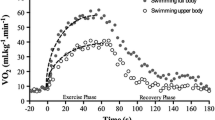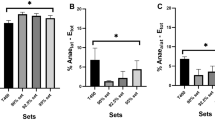Summary
The purpose of this study was to evaluate the accuracy and feasibility of estimating oxygen consumption (\(\dot VO_2 \)) during maximal swimming by using the backward extrapolation (BE) of the\(\dot VO_2 \) recovery curve to time zero. Two series of experiments were conducted. In the first, the validity of the BE method was ascertained by comparing the\(\dot VO_2 \) peak values obtained during free swimming (Douglas bag technique) with those estimated by the BE method during recovery after the same tests. These results were also compared with\(\dot VO_2 \) peak measured during uphill treatmill running.\(\dot VO_2 \) peak measured during maximal free swimming and estimated by the BE method during the recovery period of that test, were not significantly different. No significant difference was found between\(\dot VO_2 \) peak uphill treadmill running and free swimming. In the second series of experiments,\(\dot VO_2 \) peak was measured in each of 28 swimmers during uphill running (conventional method) and during unimpeded swimming using the BE method. The mean value was significantly higher during swimming (\(\overline X \)3.37) than during running (\(\overline X \)3.23). Seventy-five percent of the subjects had higher\(\dot VO_2 \) peak during swimming. The swimming speed during maximal swimming effort was 10% higher when the BE method was used then when the same subjects were tested by the conventional Douglas bag technique. The BE method is a reliable and valid way to measure\(\dot VO_2 \) peak in maximal swimming and allows the swimmer to use his specifically trained musculature fully.
Similar content being viewed by others
References
Astrand PO, Eriksson B, Nylander I, Engstrom P, Karlsberg B, Saltin B, Thoren C (1963) Girl swimmers. Acta Paediatr [Suppl] 147: 5–75
di Prampero PE, Peeters L, Margaria R (1973) Alactic O2 debt and lactic acid production after exhausting exercise in man. J Appl Physiol 34: 628–632
di Prampero PE, Cortili G, Magnani P, Saibene F (1976) Energy cost of speed skating and efficiency of work against air resistance. J Appl Physiol 40: 584–491
Holmer I, Lundin A, Eriksson B (1974) Maximum oxygen uptake during swimming and running by elite swimmers. J Appl Physiol 36: 711–714
Holmer I (1974) Physiology of swimming in man. Acta Physiol Scand [Suppl] 407
Léger LA, Seliger V, Brassard L (1980) Backward extrapolation of\(\dot VO_2 \) max from the O2 recovery curve. Med Sci Sports Exercise 12: 24–27
Magel JR (1966) Maximum oxygen uptakes of college swimmers. Ph.D. dissertation, The University of Michigan, Ann Arbor, Michigan
Magel JR, Faulkner JA (1967) Maximum oxygen uptakes of college swimmers. J Appl Physiol 22: 929
Magel JR, Foglia GF, McArdle WD, Gutin B, Pechar GS, Katch FI (1975) Specificity of swim training on maximum oxygen uptake. J Appl Physiol 38: 151–155
McArdle WD, Glaser RM, Magel JR (1971) Metabolic and cardiorespiratory response during free swimming and treadmill walking. J Appl Physiol 30: 733–738
McArdle WD, Magel JR, Delio DJ, Toner M, Chase JM (1978) Specificity of run training on\(\dot VO_2 \) max and heart rate changes during running and swimming. Med Sci Sports 10: 16–20
Roberts AD, Morton AR (1978) Total and alactic O2 debts after supramaximal work. Eur J Appl Physiol 38: 281–289
StrØmme SB, Ingjer F, Meen HD (1977) Assessment of maximal aerobic power in specifically trained athletes. J Appl Physiol 42: 833–837
Author information
Authors and Affiliations
Rights and permissions
About this article
Cite this article
Montpetit, R.R., Léger, L.A., Lavoie, JM. et al. \(\dot VO_2 \) peak during free swimming using the backward extrapolation of the O2 recovery curve. Europ. J. Appl. Physiol. 47, 385–391 (1981). https://doi.org/10.1007/BF02332966
Accepted:
Issue Date:
DOI: https://doi.org/10.1007/BF02332966




